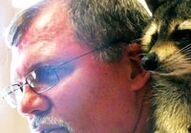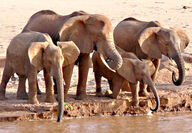Sorted by date Results 1 - 25 of 57

The African lions are large, muscular, barrel-chested cats. They have a rounded head, round ears, short fur, and a long tail with a tuft of hair at the end. Male lions grow a luxurious collar of long hair, called a “mane,” around their necks. Lions are competent predators that work together to bring down prey. They have several distinctive behaviors and adaptations that help them survive in the harsh African savannah. African lions’ famous mane begins to grow when the male lion reaches one y...

Aardvarks are small pig-like mammals that are found inhabiting a wide range of different habitats throughout Africa, south of the Sahara. They are mostly solitary and spend their days sleeping in underground burrows to protect them from the heat of the African sun, emerging in the cooler evening to search for food. Their name originates from the Afrikaans language in South Africa and means Earth Pig, due to their long snout and pig-like body. Aardvarks are unique among animals as they are the...

Madagascar is a large island nation located off the southeast coast of Africa, where some extremely unique creatures live. The fossa, a close relative of the mongoose, is Madagascar's largest predator, and the only animal to regularly and successfully hunt the islands largest lemur species. The fossa looks very much like a small, brown cougar, but it is not a cat. Fossa’s are small animals at about 15 inches at the shoulder. They are rarely more than 30 inches long, not including the equally l...

Bennett's wallabies, sometimes called red-necked wallabies, are medium-sized marsupials found along the eastern coast of Australia, and on the island of Tasmania. They are members of the macropod marsupials’ family, which also includes kangaroos and wallaroos. Though they may be best known for hopping, wallabies, kangaroos and wallaroos can also crawl and swim. In general, wallabies tend to be smaller than kangaroos and wallaroos and can be distinguished by their darker muzzle and paws. Its n...

Gray four-eyed opossums (Philander opossum) are Neotropical marsupials with a range that extends from northeastern Mexico in Tamaulipas, to southeastern Brazil. Within this range, they may be found from Brazil's Atlantic coast, west-ward into Peru and Argentina and throughout Central America in tropical lowlands and the Amazon and Parana basins. They are found mainly in tropical forested areas such as tropical evergreen, secondary growth and gallery forests. These opossums generally prefer damp...

Ringtail cats are not related to the cat family but are members of the raccoon family, Procyonidae which also includes Kinkajous, and Coatimundis. Ringtails are cat sized animals that resemble a mix between a fox and a raccoon. The face is fox-like, with a pointed snout, and the body is raccoon-like and elongated. The top side of the animal is yellow to dark brown or black, and the underside is a whitish buff. The ears and eyes are large and the eyes are ringed by white fur. The tail is very...

The Tayra is a member of the weasel family (Mustelidae), which also includes otters, skunks and minks. It is the only species in the genus Eira. The Tayra, also spelled “Tiara”, is sometimes called “swamp or bush dog” and its Creole name is Haka. Tayras can be found in the neo-tropical forests of Central and South America, and ranges from Mexico, south to Bolivia and northern Argentina and also on the island of Trinidad. In these areas they live in tropical, deciduous and evergreen forests...

The Red Panda is endemic to the Himalayas in Bhutan, southern China, India, Laos, Nepal and Burma. The Red Panda is the state animal in the Indian state of Sikkim.. Red Pandas look quite different to the Giant Pandas, they more resemble the appearance of a raccoon or weasel type animal. The Red Panda is also known as the ‘Lesser Panda (Wah), Cat Bear’, or ‘Firefox’. Being called a ‘Wah’ is because of its distinctive cry. Red Pandas are most closely related to the raccoon and are now in a family...

Elephants are the largest land animals on Earth and are also known to be extremely intelligent. They have characteristic long noses, or trunks; large, floppy ears; and wide, thick legs. A group of elephants is called a herd. The herd is led by a matriarch, which is the oldest female. Females, as well as young and old elephants, stick together in a herd. Adult males tend to wander. Elephants also have certain rules. For example, when they are meeting each other, they expect the other elephant to...

Common genets, also called small-spotted genets, are related to civets. They are common in Africa, and a few are found in western Europe. Genets live alone or in pairs, resting by day in sheltered spots or abandoned burrows. They feed at night, hunting for small animals in a range of habitats, from dense forest to open grassland. They climb trees to prey on roosting birds or silently stalk victims on the ground. These genets are adept at climbing and hunting off the ground. Their sharp claws whi...

We have just bought a new place in the country so we can expand our small educational zoo and take in more disabled, special needs, abused and unwanted wildlife and exotics. We have been asking for donations and help. We need new enclosures, toys , play skool houses, dog igloos, blankets and dog food. Anything we could use. Its not the moving for us that is hard, it's relocating all of our animals and setting up with new accommodations for them. There is a lot of work that goes into owning a...

An American Badger, are they considered fearless and vicious as we have portrayed them for years? The answer is they are no less vicious than any other animal when it comes to cubs, food or dens. However, there is another badger species that carries that title with full respect of all species. It’s the Honey Badger, considered the most fearless and vicious of all badger species. The American Badger is a brown fur-covered mammal with short legs and low profile. The head appears pointed and s...

The Capybara is a large, semi-aquatic rodent that is found inhabiting the water-logged regions of Central and South America. Closely related to other South American rodents such as Chinchillas and Guinea Pigs, the Capybara is the largest rodent in the world weighing up to 145 lbs and measuring nearly 4 feet long. Despite their enormous size though, these mammals have adapted well to life in the water and have a number of distinctive characteristics that aid their amphibious lifestyle, including...

What to do if you encounter a raccoon out in the day. If you see a raccoon, no matter what time of day, leave it alone it's a wild animal. Never try to feed it or approach it. Seeing a raccoon out in the day isn't an immediate cause for alarm. There are many reasons why this nocturnal animal might be out and about. If you live in an urban setting, or if the year has been bad for food, raccoons will change their habits to fit when food is most available. If you always put your garbage out in the...

The Raccoon dog, also known as Magnut or Tanuki, is a type of Asian wild dog it is very much a member of the dog family. It is considered to be one of the earliest species that other dog species have evolved from. Neither a raccoon nor a dog, but it does belong to the canid family, which is a lineage that includes dogs, wolves, and foxes. There are 5 subspecies of raccoon dogs that can be found in the eastern Asia and Europe. These animals inhabit dense forests and live close to the water. Numbe...

The fascinating Tasmanian devil is a carnivorous, semi-nocturnal creature, whose aggressive nature and wild hissing, growling and screaming earned it the name. Tasmanian devils live in Tasmania, a large island just south of Australia. In fact, Tasmania is the only place where they are found in the wild. Though Tasmanian devils can live anywhere on the island, they prefer coastal scrublands and forests. Tasmanian devils’ life span in the wild is about seven to eight years. The Tasmanian devil i...

Ringtail cats are not related to the cat family but are members of the raccoon family, Procyonidae which also includes Kinkajous, and Coatimundis. Ringtails are cat sized animals that resemble a mix between a fox and a raccoon. The face is fox-like, with a pointed snout, and the body is raccoon-like and elongated. The top side of the animal is yellow to dark brown or black, and the underside is a whitish buff. The ears and eyes are large and the eyes are ringed by white fur. The tail is very...

My children have four paws. My grandchildren have fur. My four legged fur kids are smarter than your honor student." Whether boasted on a bumper sticker or proclaimed aloud, these phrases capture the importance people place on their relationships with their pets. Indeed, the relationship between human and animal is special. The loss of a pet is devastating, and many pet owners find the grief associated with the loss of a pet is just as or even more challenging than the loss of human loved ones....

The Fishing cat is yet another example of a cat that disproves the misconception that cats don't like water. The Fishing Cat is a small to medium sized feline that is natively found throughout a number of countries in south-east Asia. Unlike other cat species found around the world (with the notable exception of the Jaguar) the Fishing Cat spends most of its life in areas of dense vegetation close to water and is an excellent swimmer. However, despite its water-loving lifestyle, the Fishing Cat...

Saint Francis of Assisi changed the world during his brief life, and he is still remembered worldwide today for the miracles people say God performed through him and the compassion he showed to the vulnerable -- especially poor people, sick people, and animals. The man who became known as Francis of Assisi was born Giovanni di Pietro di Bernadone in Assisi, Umbria (which is now part of Italy) around 1181 into a wealthy family. He lived a life of leisure in his youth, but he was restless, and by...

The coati is a medium-sized mammal only found on the American continent. The coati is found widely distributed across North, Central and South in a number of different habitats. The coati is primarily found in dense forests and wet jungles as the coati will spend a great deal of its life in the safety of the trees. However, there are also coati populations inhabiting grasslands, mountains and even deserts across the continent. Coatis are members of the Procyonidae family, a group of New World...

Elephants are the largest land animals on Earth and are also known to be extremely intelligent. They have characteristic long noses, or trunks; large, floppy ears; and wide, thick legs. A group of elephants is called a herd. The herd is led by a matriarch, which is the oldest female. Females, as well as young and old elephants, stick together in a herd. Adult males tend to wander. Elephants also have certain rules. For example, when they are meeting each other, they expect the other elephant to...

The Raccoon dog, also known as Magnut or Tanuki, is a type of Asian wild dog it is very much a member of the dog family. It is considered to be one of the earliest species that other dog species have evolved from. Neither a raccoon nor a dog, but it does belong to the canid family, which is a lineage that includes dogs, wolves, and foxes. They are the only Canid that hibernates in the winter. There are 5 subspecies of raccoon dogs that can be found in the eastern Asia and Europe. These animals...

Pronghorn is antelope-like animal that lives in North America. There are four subspecies of pronghorn that can be found in Mexico, Arizona, throughout the Great Plains and in the Canada. Pronghorn inhabits open grasslands and deserts. It can survive on the altitude of up to 11 000 feet. Main factors that decrease number of pronghorns in the wild are habitat loss, hunting and manmade fences for the livestock (they disturb natural migratory routes). Mexican population of pronghorns is critically...

Binturongs have a body length between 24 - 38 inches, a tail length between 22 - 35 inches and they weigh between 20 - 31 lbs. Their fur is thick, coarse and black in color and they have a long, bushy, fully prehensile tail. Their ears are small and rounded and they have tufts of hair on the end. They have small eyes that are reddish/brown in color. Binturongs are excellent climbers and they can rotate their hind legs backwards so they can still grip onto a tree when climbing down it head...